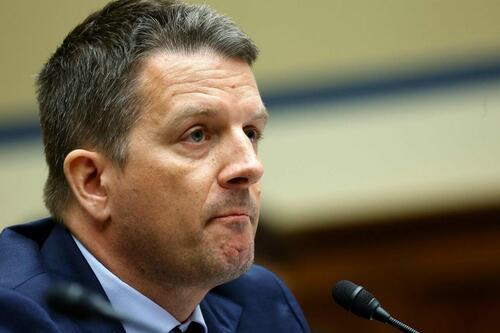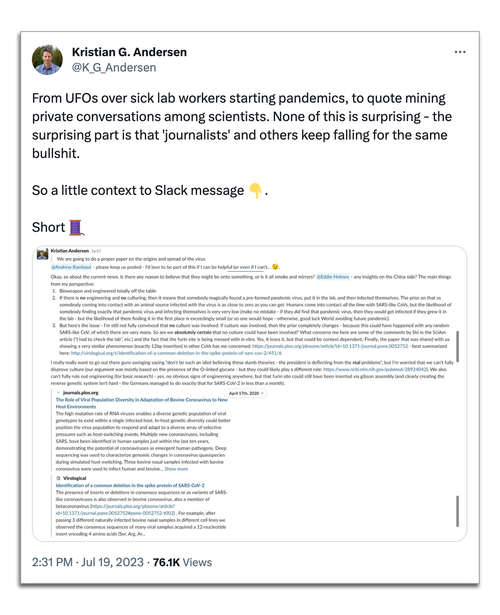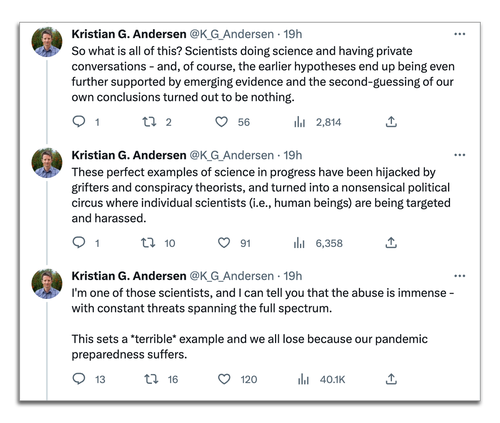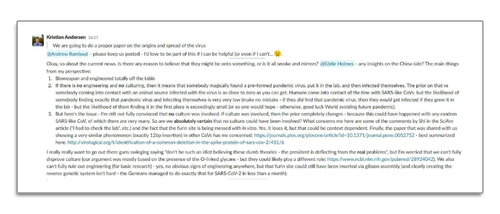Scientist Who Privately Said Lab-Leak ‘Not Some Fringe Theory’ Calls Reporting On This A ‘Conspiracy Theory’
The good folks at Racket News and Public (Matt Taibbi, Michael Shellenberger, Alex Gutentag, Leighton Woodhouse, et al.) recently dumped the entire cache of slack messages between several scientists assembled to ‘get to the bottom’ of how Sars-CoV-2 emerged. While the group clearly thought it was a lab-leak at first, it’s obvious that they succumbed to political pressure – and became more concerned over optics than simply admitting “it could have also come from the lab, we dunno.”

One of the scientists featured prominently in the Slack messages, Dr. Kristian Andersen, has hit back – calling the release of these communications “a conspiracy theory.”
As Alex Gutentag, Leighton Woodhouse and Michael Shellenberger note in Public (where one can download full versions of slack and email exchanges between the scientists).
* * *
The three of us and Matt Taibbi of Racket spread “conspiracy theories” and engaged in “quote mining” for our Tuesday scoop, “Top Scientists Misled Congress About Covid Origins, Newly Released Emails And Messages Show,” according to Kristian Andersen, the scientist who was the main subject of our article. The only thing his messages revealed, Andersen said, was “Scientists doing science and having private conversations.” (Andersen did not respond to our requests for comment.)
“None of this is surprising — the surprising part is that ‘journalists’ and others keep falling for the same bullshit,” wrote Andersen.
But his emails and Slack messages show that there was nothing theoretical about his conspiracy to discredit the lab leak hypothesis. Andersen makes clear in his messages that the purpose of the “Proximal Origin” paper was to “disprove,” in his words, the lab leak hypothesis. It was a propaganda exercise, not a scientific one.
The documents that Public and Racket were the first to report on show Andersen and his co-authors, Andrew Rambaut, Edward C. Holmes, and Robert F. Garry, conspiring — by which we mean they made secret plans to engage in deceptive and unethical behavior and — to spread disinformation. Their conspiracy included coordinating with their “higher-ups” in the US and UK governments to deceive journalists, including a New York Times reporter.
Our reporting led several people sympathetic to the lab leak hypothesis to demand the release of all the emails and Slack messages. “This calls for more transparency,” tweeted Zeynep Tufecki, a professor at Columbia University and a contributor to the New York Times, “rather than selective, partial releases —especially since the messages imply coordinated efforts for manipulating journalists etc…”
We agree and are thus happy today to release the full cache of Slack messages and emails covering the discussions between Andersen et al. as they wrote their influential “Proximal Origin,” paper, which Anthony Fauci and others in the US government used to dismiss the lab leak hypothesis.
The messages vindicated researchers like the Broad Center’s Alina Chan, who coauthored a major book, Viral: The Search For Covid’s Origin, with British science journalist Matt Ridley, who Public interviewed for a podcast last month.
“It’s ironic,” Chan told Public, “that these scientists who wanted to shut down conspiracy theories ended up starting their own conspiracy to prematurely dismiss a lab origin of Covid-19. Whether intentionally or not, their actions have steered a large portion of journalists and other scientists away from asking reasonable questions about how the pandemic started.”
Jamie Metzl, Senior Fellow of the Atlantic Council, another long-time supporter of the lab leak hypothesis, tweeted, “While the @nytimes was blindly and unquestioningly following the lead of the Proximal Origin authors [Andersen et al.] re #COVID19 origins, those scientists were scheming to manipulate NYT coverage. It’s time for the NYT to review its disastrous coverage of the pandemic origins issue.”
The New York Times, and other mainstream news reports, might start by reviewing these takeaways from our Tuesday scoop:
-
The scientists never really blamed the pangolins
The authors blamed pangolins in “Proximal Origin” even though they said, privately, that they were not convinced pangolins were a likely intermediate host between bats and humans.
Here’s what Andersen et al. wrote in “Proximal Origin”: “The presence in pangolins of an RBD [receptor binding domain] very similar to that of SARS-CoV-2 means that we can infer this was also probably in the virus that jumped to humans.”
Here’s what Andersen said shortly before the “Proximal Origin” pre-print was published: “For all I know, people could have infected the pangolin, not the other way.” Said Andersen the day after the pre-print: “Clearly none of these pangolin sequences was the source though.”
-
Scientists thought lab leak was “Friggin’ likely”
The scientists were far more suspicious of a lab origin than was previously known. The clearest example of this was when Andersen said on February 1, 2020, “I think the main thing still in my mind is that the lab escape version of this is so friggin’ likely to have happened because they were already doing this type of work and the molecular data is fully consistent with that scenario.” In fact, the original name of the channel was “project-wuhan_engineering” until February 6, when Andersen changed it to “project-wuhan_pangolin.”
-
Scientists thought lab leak was possible months after saying otherwise
The messages reveal that Andersen still suspected that a lab leak was possible in mid-April, a full month after Nature Medicine officially published “Proximal Origin,” and two months after the authors published a preprint. “I’m still not fully convinced that no culture was involved,” Andersen wrote to his co-authors on April 16. “We also can’t fully rule out engineering (for basic research).” As we noted on Tuesday, if Andersen wasn’t convinced that no culturing was possible, why did he rule out “any type of laboratory-based scenario” in his paper?
-
“I’m dismissing him” said top scientist about Times reporter
The scientists attempted to deliberately misdirect a New York Times veteran science journalist, Donald McNeil. When approached by McNeil with questions about a possible lab leak, members of the Slack channel coordinated with each other to lead him away from the theory. “It would be prudent to continue to pre-think responses” to McNeil, Garry suggested. Andersen told his fellow authors that one of his replies to McNeil “includes humor to deflect from the fact that I’m dismissing him.”
-
Scientists suspected the Bat Lady of the lab leak
The scientists were specifically discussing experiments being performed in the lab of Shi Zhengli, the infamous “bat lady of China,” at the Wuhan Institute of Virology. That’s the same lab where three researchers became sick with Covid-like symptoms in 2019. Andersen discussed some of her papers in early February, and noted his concerns about gain-of-function experiments on MERS and SARS viruses. in mid-April he noted that Shi’s work was “the main reason I have been so concerned about the ‘culture’ scenario.” Cell culturing is a method through which viruses can be passed multiple times through cells in order to render them more infectious, and is exactly the kind of “laboratory-based scenario” the authors ruled out in their paper.
-
The scientists’ conspiracy was driven by obedience to “higher-ups” in US and UK governments
The scientists were responding to “higher-ups.” Although the identities of these “higher-ups” remain to be further investigated, the new documents and Congressional interviews suggest that the “higher ups” may be Jeremy Farrar of the Wellcome trust, Anthony Fauci, Francis Collins, government agencies, and/or the intelligence community.
The New York Times and Washington Post have yet to cover the conspiracy by Andersen and his colleagues to misinform the public. But whatever they decide to do, the question is why Public, Racket, and intrepid reporters like Lee Fang keep getting the big scoops and they don’t.
After all, we have broken some of the biggest stories in the world over the last several months, from the Twitter Files and the global crackdown on free speech to Covid’s origins to FBI and UAP whistleblowers. Often, our stories are confirmed days or weeks later by much larger news media companies and even U.S. Senators. Taibbi has done more than anyone to uncover the disinformation of the Censorship Industrial Complex, while Fang exposed how the FBI helps the Ukrainian government censor ordinary American citizens on Facebook.
Public, Racket, Fang, and other small fry like us shouldn’t be scooping news behemoths. The New York Times had over $2.2 billion in revenue last year, which is over 2,200 times more revenue than Public will have in 2023. All combined, Public, Racket, and Fang have fewer than 12 employees. Why, then, do we keep scooping the Times, the Post, and other major media outlets?
To answer that question, it’s important to understand why the New York Times pushed out Don McNeil, the reporter who Andersen et al. conspired to deceive.
* * *
The last word goes to Matt Taibbi, who writes in Racket News;
Public has just published the cache of communications of the scientists who penned the key article, The Proximal Origin of SARS CoV-2, that was used to dismiss the possibility that Covid-19 was caused by a lab accident. Michael Shellenberger, Alex Gutentag, Leighton Woodhouse, and the rest of the staff of Public can’t be commended enough for doing the hard work to get this material out — you can find it linked here — and I strongly recommend that anyone with time read the docs from start to finish.
If you read the documents up at Public like a novel, and follow the chorus-like Slack exchanges between the four key scientists as a drama with a beginning, middle, and end, it’s hard to miss the brutal lesson. Four people whose job was to divine truth through scientific analysis were waylaid by social and political considerations that you can see attacking each of the characters with ferocity, even in their little digital haven of a private chat. With everything on the line, and millions of lives at stake, they were not only unable in the end to say what they really thought, but as my partner Walter Kirn points out, they joined up with a mechanism that worked to suppress and stamp out the very thoughts they themselves first had.
The problem that’s been threatening Western democracies for years, and which is captured in books like Martin Gurri’s The Revolt of the Public, is the widespread loss of faith in institutional authority. At first this was a technical problem, caused by a monstrous new surfeit of information on the Internet, allowing the public for the first time to see warts that were always there. What’s happening now is different. Even those of us who never trusted leaders before at least trusted such people to act in their self-interest. We thought that in emergencies, even the worst officials would suspend their stealing and conniving long enough to do the bare minimum.
As these documents show, however, we can’t even have that expectation. Once people see an institutional malfunction on this scale, it’s like walking in on a cheating spouse, they can’t unsee it. That’s what these scientists were risking when they played around with a lie this big: everything. They may not have been evil exactly — “more Three Stooges than Ocean’s Eleven” is how one scientist put it to me — but their bumbling inability to find their consciences under pressure in the first months of 2020 might end up having lasting consequences, for society and science. In any case, conceding that in media we get lost in the moment a lot and often think what’s happening today is far more important than what happened yesterday, what they have over at Public is historic stuff. I hope you find time to discover it for yourselves.
Tyler Durden
Thu, 07/20/2023 – 17:40
Zero Hedge’s mission is to widen the scope of financial, economic and political information available to the professional investing public, to skeptically examine and, where necessary, attack the flaccid institution that financial journalism has become, to liberate oppressed knowledge, to provide analysis uninhibited by political constraint and to facilitate information’s unending quest for freedom. Visit https://www.zerohedge.com









